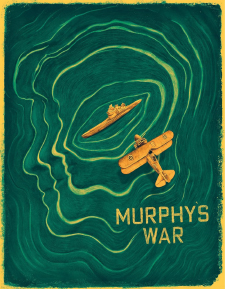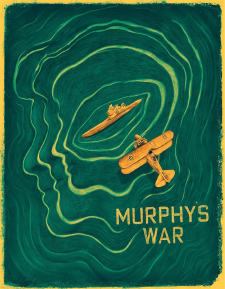Murphy's War (Blu-ray Review)

Director
Peter YatesRelease Date(s)
1971 (January 30, 2024)Studio(s)
Paramount Pictures (Arrow Video)- Film/Program Grade: B
- Video Grade: A
- Audio Grade: A
- Extras Grade: A
Review
Murphy’s War is an impressive-looking vengeance action World War II drama shot on location in Venezuela. Reminiscent of The African Queen and Moby Dick, the film focuses on the survivor of a ship sunk by a German submarine who’s obsessed with avenging the deaths of his shipmates.
During the final days of the war, the commander of German U-boat that sinks the ship (Horst Janson, Captain Kronos, Vampire Hunter) orders his crew to fire on the helpless men bobbing in the sea in their life jackets. Most of the men are killed but Murphy (Peter O’Toole, Lawrence of Arabia) remains alive. Native villagers find the badly injured Murphy and carry him to a missionary infirmary, where he’s nursed back to health by Dr. Hayden (Sian Phillips, Clash of the Titans). A second survivor has beached an amphibious airplane a few miles downstream on the Orinoco River, where the U-boat is concealed. With the help of Frenchman Luis Brezan (Philippe Noiret, Cinema Paradiso), Murphy tows the plane, patches it up and sets out to sink the submarine.
A good deal of screen time is devoted to the attempt to get the plane airborne as it races through the river, water splashing over the engine and cockpit. Murphy stubbornly pushes the aircraft until it finally takes to the air. He spots the U-boat, partially hidden by trees near the shore, and returns to fashion a homemade bomb that can destroy the sub. Murphy and Brezan go forward with the risky plan, driven more by Murphy’s personal desire for vengeance than by patriotic fervor. Later, Murphy uses Brezan’s dilapidated dredging barge to ram the sub.
Murphy’s obsession with revenge both inspires and frightens Dr. Hayden and Brezan. His mission to destroy the enemy submarine and its crew is sheer lunacy, yet he cobbles together a plan that he’s convinced will work. The wild look in O’Toole’s eyes and his reckless manner convey Murphy’s compulsive determination.
Noiret plays Murphy’s capable, sensible sidekick, willing to help until the mission becomes untenable. It takes Brezan a long time to realize that Murphy is tilting at windmills and bordering on madness. As the doctor, Phillips has only a couple of meaty scenes, one when her character tends to Murphy as villagers watch from the doorway, the other when she stands up to the German sub commander who comes ashore looking for a British pilot, but her acting lacks conviction.
Director Peter Yates (Bullitt) has created exciting scenes, particularly when the small plane attacks and the sub’s crew fires back with heavy deck guns, and when the barge is used in connection with an unexploded torpedo to vanquish the sub and its crew. He’s less successful when the plane struggles to get into the air. The sequence goes on so long that the suspense turns to tedium. We get it. It’s tough to get the patched-together plane to fly!
The thrust of the film is action-oriented but it also comes off as a comment on the futility, the ironies, the waste, inconsistencies and avoidable tragedies of warfare. Murphy’s failures fuel his growing obsession with destroying the sub just as the white whale’s repeated thwarting of Ahab fuels his obsessive attempts to hunt it down.
The aerial photography and Douglas Slocombe’s color photography give the film a rich look. The 1940 British submarine painted to look like a German sub is impressive. Its presence in Venezuela when the Germans are making a last stand in Europe seems unlikely, but visually it evokes the Goliath to Murphy’s David.
Murphy’s War was shot by director of photography Douglas Slocombe (Raiders of the Lost Ark) on 35 mm Eastmancolor film with anamorphic Panavision lenses and presented in the aspect ratio of 2.35:1. The master was supplied by Paramount Pictures. There’s no additional information on which elements were used. Clarity and contrast are excellent. Most scenes take place during the daytime. The sun-drenched scenes reflect the oppressive heat of the jungle. The color palette includes vivid greens of the tropical jungle, Brezan’s grungy brown barge, the yellow cloud of an explosion, the changing hues of the river from grey to deep blue, the shiny blue sea plane, and brilliant reds of a flock of birds. Details such as whiskers on O’Toole and Noiret, equipment on the barge, grass-roofed huts on the beach, and the sandy beach itself are well delineated. Complexions are well rendered, with O’Toole and Noiret’s faces covered with perspiration when they work and O’Toole’s intense blue eyes sparkling in his deeply tanned face.
The soundtrack is English LPCM Mono. Optional English SDH subtitles are available. Dialogue is clear for the most part, but O’Toole’s Irish accent is often hard to understand and he isn’t consistent with it, often varying his normal speech with a heavy accent. A dominant sound effect is the patched-up plane struggling to take off and finally in flight over the river. Other key sound effects are gunfire from the deck guns of the submarine, underwater sounds of the sub, chaos as Murphy’s ship is sunk, and machine guns picking off survivors in the ocean. John Barry’s score enhances the action sequences.
Bonus materials on the Region A Blu-ray release from Arrow Video include the following:
- Running Out of War (19:49)
- A Great Adventure (31:07)
- Dougie, Chic and Me (17:17)
- One Man Army (17:18)
- Theatrical Trailer (3:17)
- Image Gallery (:17)
Running Out of War – In this visual essay, film critic David Cairns notes that Murphy’s War was adapted from a novel by Max Catto. A profile of Paramount Pictures at the time is provided. Robert Evans had made several hits for the studio. Peter Yates, the director, had a hit with Bullitt. The three characters in Murphy’s War each act in ways that make them feel better about themselves. Stirling Silliphant had won an Oscar for the screenplay for In the Heat of the Night. Half of the budget for Murphy’s War was raised from Dimitri De Grunwald, a pioneer of pre-selling films to raise the funds to shoot them. The location of the film was originally intended to be Jamaica but because of its instability, Venezuela, which had never hosted a Hollywood film, was chosen. In the script, the doctor was changed from male to female and Murphy was changed from Australian to Irish to better suit O’Toole. The film, a box office disappointment, illustrates “the absurdity of war.”
A Great Adventure – John Glen speaks in this archive interview about his beginnings in the film industry, working as a sound editor, assistant director, and second unit director. He worked on the TV show Danger Man with Peter Yates, directing inserts and eventually moving up to directing action sequences. He eventually directed the James Bond feature Octopussy. Actor Steve McQueen had seen Peter Yates’ film Robbery, was impressed with the car chases, and wanted Yates to stage the most elaborate car chase ever for Bullitt. Filming Murphy’s War in Venezuela was difficult. The film’s locations were so remote that the whole crew had to be housed in an old Irish ferry. However, the river wasn’t deep enough for the boat to get close to the location, so smaller boats had to carry cast and crew to the locations each day, taking up a great deal of time. The houses along the Orinoco River are built on stilts because the river’s level rises to 30 or 40 feet, depending on the season. The native people of the area were very nice to cast and crew.
Dougie, Chic and Me – Douglas Slocombe, Chic Waterson and Robin Vidgeon comprised the photography team on Murphy’s War. They worked with many fine directors through the years. According to focus puller Robin Vidgeon, Slocombe “painted lovely pictures.” To photograph women, Slocombe would put a piece of mesh over the lens, which would be flattering to the subject. He always worked with the script in mind. Sometimes, because it was bright outdoors, filters had to be used to cut the intensity of the light. The focus puller puts on the right lenses and measures the distance between camera and subject. Vidgeon notes that making Murphy’s War “was a happy shoot.”
One Man Army – In this archive interview with film critic Sheldon Hall, Murphy’s War is filled with ironies. The American film industry at the time was in crisis because changing tastes of the public doomed many big-budget pictures. This led to the withdrawal of financing of international films. Murphy’s War got in just “under the wire.” Its budget was $5 million. The film did well in its initial London release but not in the rest of England. In the United States, where war films were “sticky in the late 1960s,” it grossed less than $1 million. World War II films had dipped in popularity. Murphy’s War represented the end of an era. Its failure at the box office led to a hiatus of about six years in the production of movies about World War II.
Image Gallery – Seventeen color still photos from Murphy’s War are shown.
Booklet – The 24-page booklet contains the essay A Versatile But Underrated Director? by Philip Kemp; 15 color stills from the film; and cast and key crew listing.
Murphy’s War is predicated on the title character’s determination to seek personal vengeance against the submarine that not only sank his ship but whose commander ordered the wholesale killing of helpless men floating in the sea. We root for Murphy. His one-man vendetta seems heroic, given his isolation with only two people—a sympathetic doctor and a barge owner—to support him. O’Toole infuses Murphy with bravado but it becomes clear that his apparent heroism is actually mad obsession. The film offers some good action sequences but never achieves the heights of such World War II pictures as The Bridge on the River Kwai, The Dirty Dozen, or The Great Escape.
- Dennis Seuling

